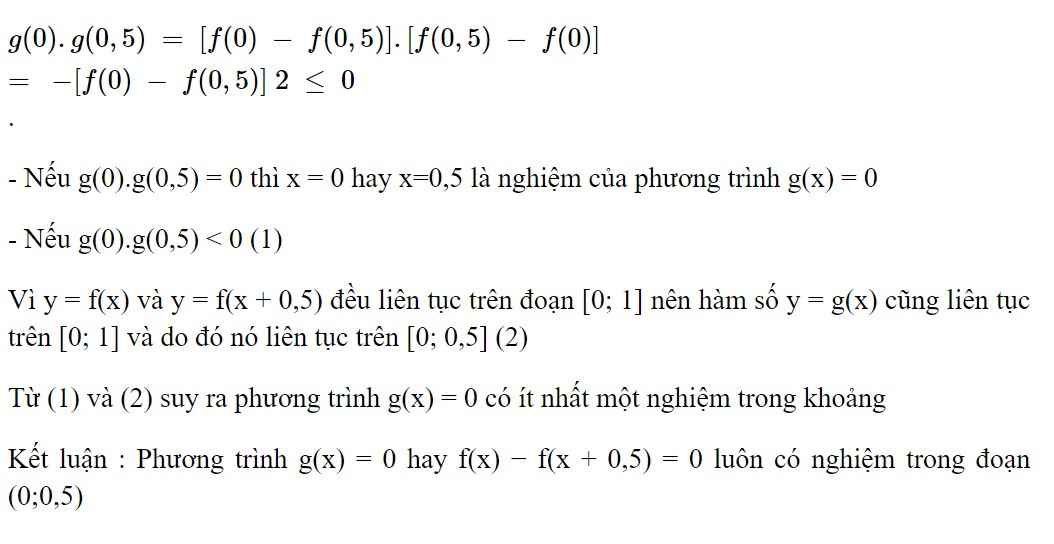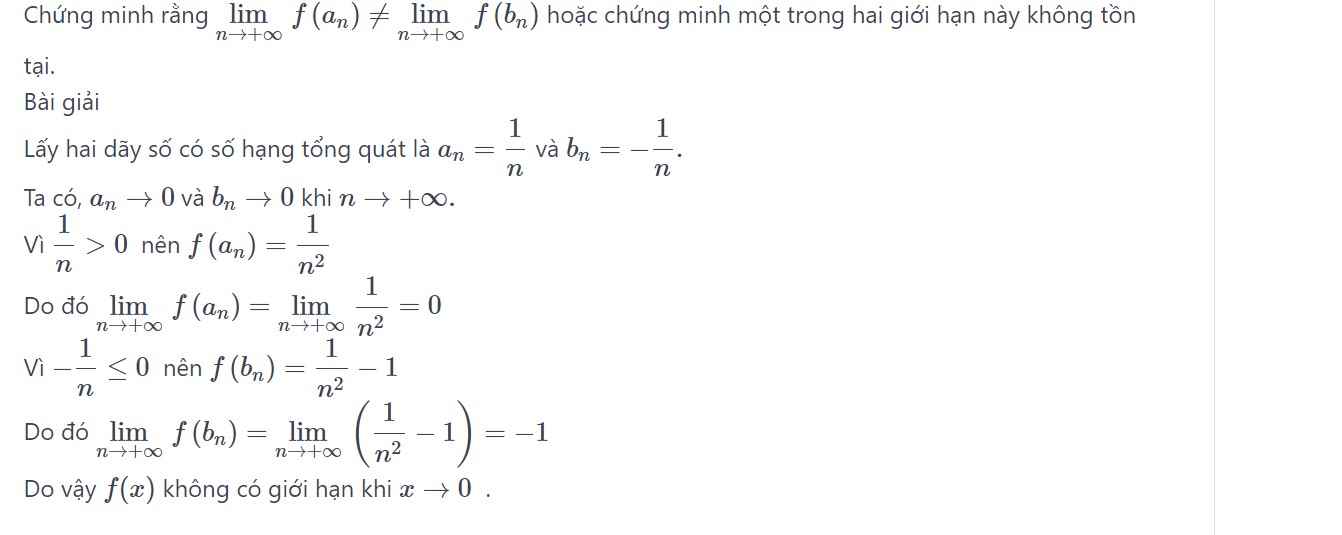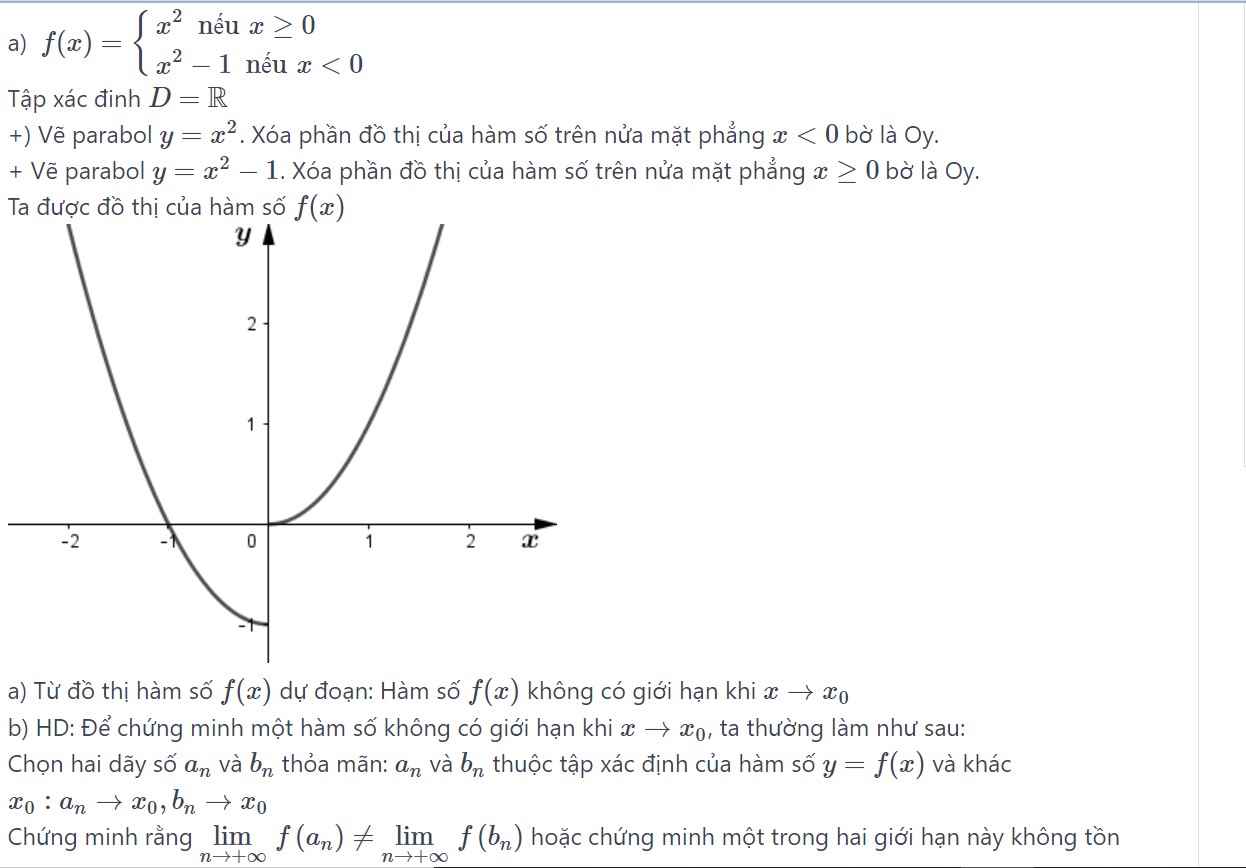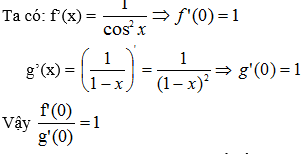Hãy nhập câu hỏi của bạn vào đây, nếu là tài khoản VIP, bạn sẽ được ưu tiên trả lời.

Tham khảo:
Xét hàm số g(x) = f(x) − f(x + 0,5)
Ta có
g(0) = f(0) − f(0 + 0,5) = f(0) − f(0,5)
g(0,5) = f(0,5) − f(0,5 + 0,5) = f(0,5) − f(1) = f(0,5) − f(0)
(vì theo giả thiết f(0) = f(1)).
Do đó,


\(\lim\limits_{x\rightarrow0}\left|f\left(x\right)\right|=\lim\limits_{x\rightarrow0}\left|x^2sin\dfrac{1}{x}\right|< \lim\limits_{x\rightarrow0}\left|x^2\right|=0\).
Vậy \(\lim\limits_{x\rightarrow0}f\left(x\right)=0\).
\(f\left(0\right)=A\).
Để hàm số liên tục tại \(x=0\) thì \(\lim\limits_{x\rightarrow0}f\left(x\right)=f\left(0\right)\Leftrightarrow A=0\).
Để xét hàm số có đạo hàm tại \(x=0\) ta xét giới hạn:
\(\lim\limits_{x\rightarrow0}\dfrac{f\left(x\right)-f\left(0\right)}{x-0}=\lim\limits_{x\rightarrow0}\dfrac{x^2sin\dfrac{1}{x}}{x}=\lim\limits_{x\rightarrow0}xsin\dfrac{1}{x}=0\).
Vậy hàm số có đạo hàm tại \(x=0\).

Ta xét bảng sau đây :
x 1 2 x-1 2 x-2 f(x) 1-x 4-2x 5-3x x-1 4-2x 3-x x-1 2x-4 3x-5
Ta có ngay với \(x\ne1\) và \(x\ne2\)
\(f'\left(x\right)=\begin{cases}-3;x< 1\\-1;1< x< 2\\3;x>2\end{cases}\)
Bây giờ xét tại \(x=1\), ta có
\(\lim\limits_{\Delta x\rightarrow0^+}\frac{f\left(1+\Delta x\right)-f\left(1\right)}{\Delta x}=\lim\limits_{\Delta x\rightarrow0^+}\frac{3-\left(1+\Delta x\right)-2}{\Delta x}=\lim\limits_{\Delta x\rightarrow0^+}\frac{-\Delta x}{\Delta x}=-1\)
\(\lim\limits_{\Delta x\rightarrow0^-}\frac{f\left(1+\Delta x\right)-f\left(1\right)}{\Delta x}\ne\lim\limits_{\Delta x\rightarrow0^-}\frac{5-3\left(1+\Delta x\right)-2}{\Delta x}=\lim\limits_{\Delta x\rightarrow0^-}\frac{-3\Delta x}{\Delta x}=-3\)
Như vậy \(\lim\limits_{\Delta x\rightarrow0^+}\frac{f\left(1+\Delta x\right)-f\left(1\right)}{\Delta x}\ne\lim\limits_{\Delta x\rightarrow0^-}\frac{f\left(1+\Delta x\right)-f\left(1\right)}{\Delta x}\)
Nghĩa là không tồn tại đạo hàm của \(f\left(x\right)\) tại \(x=1\)
Tương tự không tồn tại đạo hàm của \(f\left(x\right)\) tại \(x=2\)

Theo định nghĩa ta có :
\(f'\left(x\right)=\lim\limits_{\Delta x\rightarrow0}\frac{f\left(a+\right)-f\left(a\right)}{\Delta x}\)
\(=\lim\limits_{\Delta x\rightarrow0}\frac{\left(a+\Delta x-1\right)\varphi\left(a+\Delta x\right)}{\Delta x}\) do (\(f\left(a\right)=0\))
\(=\lim\limits_{\Delta x\rightarrow0}\varphi\left(a+\Delta x\right)\)
Khi \(\Delta x\rightarrow0\) thì \(a+\Delta x\rightarrow a\) và do \(\varphi\left(x\right)\) là hàm liên tục tại x = a nên có :
\(\lim\limits_{\Delta x\rightarrow0}\varphi\left(a+\Delta x\right)=\varphi\left(a\right)\)
Vậy \(f'\left(a\right)=\varphi\left(a\right)\)




\(f'\left(x\right)=4x\Rightarrow y=2x^2+1-4x\)
\(y'\left(x\right)=4x-4=0\Rightarrow x=1\)